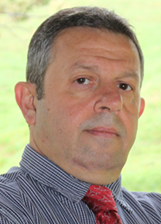Tutorials
Wireless charging and wide bandgap devices – a fruitful collaboration
How wide bandgap devices have enabled the development of wireless charging
Tutorial Abstract
The convenience or wirelessly charged consumer products is widely appreciated and wireless charging has an important place in industrial automation. More recently much development work has highlighted the benefits for operators of electric vehicles, for example those with disabilities. The first generation of wireless chargers operated at 20 kHz using IGBTs as the switches. These systems were successful and could deliver high powers but were large. The timely arrival of silicon carbide MOSFETs has led to practical 85 kHz systems up to 20 kW or more. Research work is now focusing on megahertz systems using GaN devices to achieve more compact, and potentially lower cost, solutions.
The tutorial will cover the crucial role that wideband gap devices has played in the development of contemporary high-power wireless charging with examples from several application areas.
Instructor
Professor Richard McMahon, WMG, University of Warwick, United Kingdom

Richard McMahon is Professor Electrical Power Conversion at WMG, University of Warwick. He joined the university of Warwick in 2016 having previously been at Cambridge University Engineering Department. He leads the Power Electronics, Machines and Drives activity at WMG and his team has been involved in many wireless projects including the complete design and development of an 85 kHz 20 kW system recently demonstrated in Milton Keynes. He is a Chartered Engineer and a Fellow of the IET.
Image from https://warwick.ac.uk/newsandevents/pressreleases/new_professor_of/
High Voltage Blocking Stability and Reliability Challenges for Silicon Carbide Power Devices
Tutorial Abstract
Power semiconductors differ from other semiconductor devices in their capability to sustain high voltages under extreme conditions. During static blocking (reverse bias), turn-on and turn-off switching and under special overload and fault protection conditions, high voltages are applied across the device. Together with the bulk region, having a wide and low doped drift region to support the electric field required for the high voltage ratings, the junction termination region plays the main role to shape the p-n junction edge and surface profile for obtaining a controlled electric field distribution and the maximum possible reverse voltage blocking capability.
New power devices based on wide bandgap materials such as Silicon Carbide are emerging in many power electronics applications to achieve high performance levels. The SiC material enables the power semiconductor to withstand higher voltage levels due the high critical electric field levels which are nearly ten times that of silicon. This means that the SiC device can be made ten times thinner for lowering the overall losses. The above material advantages enable device designers to employ narrower junction termination dimensions. The substantially higher cost of SiC devices is another important factor for this trend to minimise the chip size of the final product. On the other hand, stable blocking behaviour is a key target especially with respect to SiC device design through improved junction termination and passivation technologies and the ability of the package to provide extra protection against harsh environmental conditions such as high humidity and temperature variations. The impact of the higher peak electric fields situated very close to the device surface and outside the semiconductor bulk (i.e., passivation layers and package filling materials) will also be more critical than in silicon. Therefore, SiC power devices will require special attention with respect to stable blocking performance by utilizing optimum termination designs and dimensions to take into account effects inside and outside the device bulk with further improvement in passivation and packaging materials for device protection.
This tutorial aims to discuss the impact of local variations due to various extrinsic causes (manufacturing, operational or environmental) on the electrical field profile in the junction termination region and subsequently on the device voltage blocking capability and reliability. Furthermore, means of detection via special test procedures and the development of improved device protection will be included in the tutorial as well.
Instructors
Dr. Munaf T. A. Rahimo, mqSemi AG, Switzerland

Dr. Rahimo received his BSc from Baghdad University, Iraq in 1991 and his MSc/PhD from Staffordshire University, UK in 1993/1996. He joined GEC Plessey Semiconductors, UK in 1996 and then Semelab Plc, UK in 1999 where his main task in both companies involved the development of advanced fast recovery diodes technologies and products. In 2000, he joined ABB Switzerland as a power device senior R&D engineer responsible for IGBT development. Due to his many contributions to power device technologies for HVDC systems, he became ABB`s Corporate Executive Engineer in 2012. Since 2018, he is general manager of his consulting firm MTAL GmbH and founder of the power device start-up mqSemi AG in Switzerland. He has more than 30 years of accumulated experience in power devices and applications and is known for pioneering the advanced IGBT, BIGT, IGCT, Thyristor and diode concepts employed broadly in grid systems, traction and industrial drives. He has over 100 patents families including 60 families with patent grants and has authored over 200 publications and given many invited talks and tutorials.
Dr. Iulian Nistor, mqSemi AG, Switzerland
Dr. Nistor received his BSc in Physics from the Al. I. Cuza University in Romania in 2002 and his PhD degree in Electrical Engineering in 2006 from the University of Maryland, USA. He joined ABB’s Corporate Research Centre in Switzerland in 2007 developing next generation high-power semiconductor devices. He became the power device group leader in 2009 focusing on the research and development of advanced Silicon and Silicon Carbide power devices where he was instrumental in re-establishing the SiC research project at ABB. In 2015, he was the head of the power electronics R&D Department in ABB Corporate Research Centre in North America, USA. In 2018, he joined Infineon AG, Germany as a power semiconductor regional marketing manager and global application manager. In 2019, he co-founded and joined mqSemi AG as director for business development. He has more than 15 years of accumulated industrial experience in the field of power electronics and power devices with 20 patents families to his name and over 40 journal and conference papers.
Wide Bandgap Power Devices – Opportunities and Challenges in Power Electronic Systems
Tutorial abstract
In power electronic systems most of the technology development has been relying on the progress in new power semiconductors. This is also the case for Wide Bandgap Power Devices where faster switching speed, lower losses, smaller size have again put the technology forward. In some applications we see ten times faster switching speed with a significant reduction in size as well as system-wise a faster control loop bandwidth. On the other hand the layout of the power electronic circuit design become more critical to meet enough robustness of the designed system. This tutorial will touch on some of the those elements by giving examples from renewable generation and adjustable speed drive systems discussing Opportunities and Challenges of Applying Wide Bandgap Power Devices – as well as discuss future emerging topics having those new opportunities seen from a system perspective
Instructor
Professor Frede Blaabjerg, Aalborg University, Denmark

Prof. Frede Blaabjerg has been full professor at Aalborg University for almost 25 years and has been a key person to develop a strong power electronics program at Aalborg University – with a long tradition to work closely with industry – In recent years he has been establishing the Center of Reliable Power Electronic Systems (CORPE) as well as a National Research Infrastructure on reliability (X-Power) – he is Villum Investigator giving him the opportunity to take rather independent research avenues. He has received the IEEE Edison Medal.
An introduction to TCAD device modelling and simulation of wide bandgap power semiconductor
Tutorial abstract
Power devices are the fundamental building blocks of any power electronic system providing an interface between electrical systems or enabling the control of power flow. Technology computer-aided Design (TCAD) is essential for devices technology development, including wide bandgap power semiconductors. This tutorial will deal with TCAD device setup and modelling of power semiconductor devices. Examples of modelling and simulating of 4H-Silicon Carbide (SiC) devices will be presented. Modelling and simulating defects, traps and the effect of these traps on the characteristics will also be discussed
Instructor
Dr Marina Antoniou, University of Warwick, United Kingdom

Dr Marina Antoniou holds a PhD, an MEng and BA from the University of Cambridge (Trinity College). She has been the holder of several highly competitive research fellowships and grants including the Royal Society Research Fellowship 2017 (SiC Power Devices for Smart Grid Systems), a Junior Research Fellowship (Selwyn College) and an Early Career EPSRC Centre for Power Electronics award, all of which involved the design and development of SiC or Si high power devices. Marina is the Chair of the IEEE Electron Devices Society, Power Devices & ICs Committee (2022-2023), having previously served as committee member (2020-2021). Marina is also an Associate Editor for the IEEE Transactions of Electron Devices, Elsevier Power Electronic Devices and Components and the Royal Society Philosophical Transactions, the world's longest running science journal. She has previously served as a technical committee member for the IEDM (2020-2021), and the ISPSD (2015-2021), the leading international conferences in the area of electron and power semiconductor devices respectively. She is also an Executive Committee member of the IET’s PEMD Technical Network (TN).
Packaging and Integration for Wide Band-Gap Semiconductors
Tutorial abstract
With the universal uptake of commercially viable Wide Bandgap power semiconductors gathering pace, their switching speed, seen as one of their greatest advantages, is also a significant disadvantage in terms of Electro-magnetic Interference and high DV/DT delivered to the output cables and load. Present packaging technologies, often developed for Silicon devices, limit the performance of the wide bandgap devices. This tutorial will highlight the issues surrounding Electro-magnetic interference, thermal management and high speed circuit layout and outline an integrated approach to facilitate the use of these devices.
Instructor
Professor Lee Empringham, University of Nottingham, United Kingdom

Professor Lee Empringham received the B.Eng. (Hons.) degree in Electrical and Electronic Engineering from the University of Nottingham, U.K., in 1996, and the Ph.D. degree in November 2000. He then joined the Power Electronics, Machines and Control Group within the School of Electrical and Electronic Engineering, University of Nottingham, to work on matrix converter commutation techniques.
Since then, he has worked as a Research Fellow to support different ongoing Industrially based research programmes focusing on highly compact power converter applications for Aerospace, renewables and Industrial drives.
In 2010, he was appointed as a Principal Research Fellow within the group and Professor of Power Conversion Technologies in 2017 where he lead multiple integrated power electronic initiatives including the EPSRC Centre for Power Electronics Heterogeneous Integration Theme and was deputy director of both the EPSRC Automotive Challenge Network and the Advanced Propulsion Centre thematic Spoke on Power Electronics.
His research interests include direct AC–AC power conversion, variable speed AC motor drives using different circuit topologies, more-electric aircraft applications, power electronics integration, and high power density power conversion techniques. In 2017, he co-founded The thinking Pod Innovations Ltd.
Silicon Carbide epitaxy overview and new challenges
Tutorial abstract
In the last decade the market for SiC-based power devices has been grown rapidly, consequently, the demand for a high quality, defect-free, and uniform SiC materials is increased. Today, the mainstream epitaxy wafer size (to produce SiC devices) is 150 mm while, in order to reduce the production cost per unit device, some device manufacturers are in the early stages of setting up 200 mm fabs. To realize this aim, alongside the need for commercially available 200 mm SiC wafers, the ability of performing uniform SiC epitaxy with low defect density is highly demanded. So, achieved decent quality for 200 mm SiC substrates, the next challenge would be to perform high quality epitaxial growth on them.
The tutorial will give an overview on SiC epitaxy in the last decades pointing out some breakthroughs, which had speed out the SiC market growth. It will be shown the parameters, which influence the SiC epitaxy and the actual status of 150mm epitaxy quality, which is ready for some device (SBD and Mosfet). Nevertheless, improvements are needed further for very high voltage devices. Even if SiC 150mm epitaxy is still the main source for SiC device market, all the mayor SiC players are doing huge investments for 200mm SiC epitaxy. After an overview of the principal 200mm SiC epitaxy reactor suppliers, the tutorial will focus on activity on LPE reactor. The LPE company has designed and manufactured a horizontal single wafer hot-wall fully automatic CVD reactor (PE1O8A) equipped with a multi-zone injection system able to process up to 200 mm SiC substrates, with high performances in both doping and thickness uniformities. Computational fluid dynamics (CFD) simulation is used to achieve the optimum design of the PE1O8 reactor to guarantee comparable gas flow and temperature uniformity both for 150 and 200 mm substrate format. The gas blending system enables the modification of the locally distributed gas chemical composition, further expanding the number of process parameters tunable to optimize epitaxial growth. Finally, it will be shown the activity on 200m epitaxy.
Instructor
Dr. Marco Mauceri, LPE Epitaxial Technology Center, Catania, Italy

Marco Mauceri actually is a senior process engineer at LPE R&D Lab in Catania. Since 2002 he worked in LPE as process and product engineer. He was involved in several R&D projects on SiC epitaxy and SiC heteroepitaxy (SiCilab, Last Power, Challenge, Reaction, EleGaNte project, etc.). He has a master degree in physics and he was co-author in more than 50 papers.
